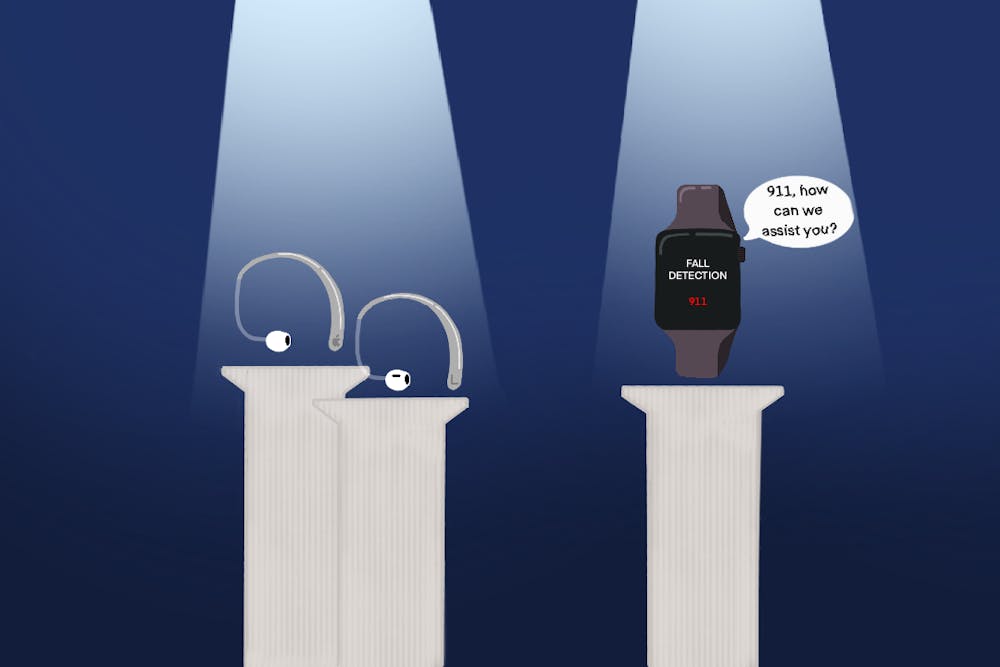Following the FDA's approval of Apple AirPods' over-the-counter hearing aid software, the gap between hearing aids and general-use earphones has shrunk. However, relying on general-purpose consumer products for medical functions raises questions about the effectiveness of new accessible technology.
Over 100 million people use AirPods globally. In the United States alone they hold 34.4% of the market share of earphones.
Valentin Dinu is an associate professor at of the College of Health Solutions and the director of the Translational Bioinformatics Lab. He highlighted that AirPods could reach a lot of people for whom hearing aids are still inaccessible.
"Sometimes (earphones) can get very expensive," Dinu said. "The Apple devices will help (make it) a bit more affordable to many people, and also for those who have a hard time going to have a hearing screening."
Jake Patten is an assistant professor at the College of Health Solutions, and also a cognitive scientist working with the Science of Art, Music and Brain Activity research group. According to him, Apple's primary target audience for the software is millennials and Gen Z who might later face hearing issues, as well as older generations who want to maintain their youthfulness.
"That might be the market that Apple's targeting — that tail end, baby boomer, beginning Gen X kind of era for (people in their) 60s," Patten said. "And then they're eyeing all of us as we age, to tap us in the future. So like, aging with the product."
Despite this increased accessibility, the FDA restrictions still limit the AirPods' features as a hearing aid.
Erica Williams is a clinical professor at the College of Health Solutions, as well as the director of the Doctor of Audiology program at ASU. As she points out, these hearing devices can only be used for people with mild to low hearing problems.
"They're not supposed to be for anyone under 18," Williams said. "They're only supposed to be for mild to moderate hearing losses without any other underlying medical etiology that needs to be treated. And so they're not appropriate for everybody, by any means."
One additional issue is that the user needs to adjust the settings to tune it to their hearing frequencies in order to work as a hearing aid. To do this, one might need a quiet room with no background sounds, which is not always easy to find.
According to Patten, having an audiologist set the right frequencies of their hearing aids in an anechoic chamber, rather than having the person do it themselves, would be ideal for preventing damage.
"The research shows that ... when you allow people to do it themselves, they end up with settings that are louder than they should be, which is not good because now you can possibly damage the hearing beyond where it already was damaged," Patten said.
Then also exists the potential of losing AirPods, which could be devastating in a situation when they are needed. Apple charges $69 for a single earphone replacement.
According to Patten, the aesthetics of the AirPods could also be a problem as they are associated with listening to music and disengaging with people.
"You might not want to wear them to dinner at first because you'll look like you're just listening to music," Patten said. "That is a place that people who need hearing aids tend to need their hearing aids, is in dining settings. There's so many people around them that are talking, and they need to focus on the people in front of them."
Apple's push into the medical devices field may redefine accessibility, but how reliable these devices are for those in need, and how they will compare to traditional hearing aids, remains to be seen.
Edited by River Graziano, Abigail Beck and Natalia Jarrett.
Reach the reporter at jnolas77@asu.edu.
Like The State Press on Facebook and follow @statepress on X.




